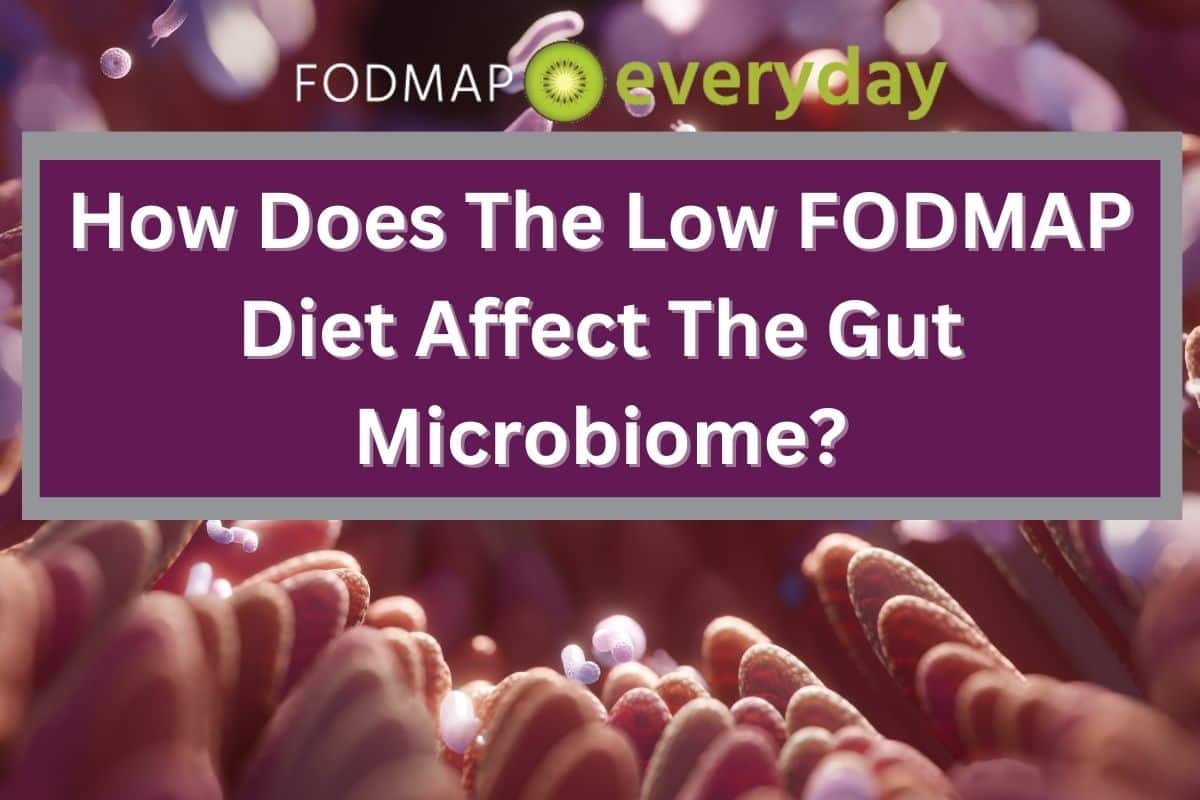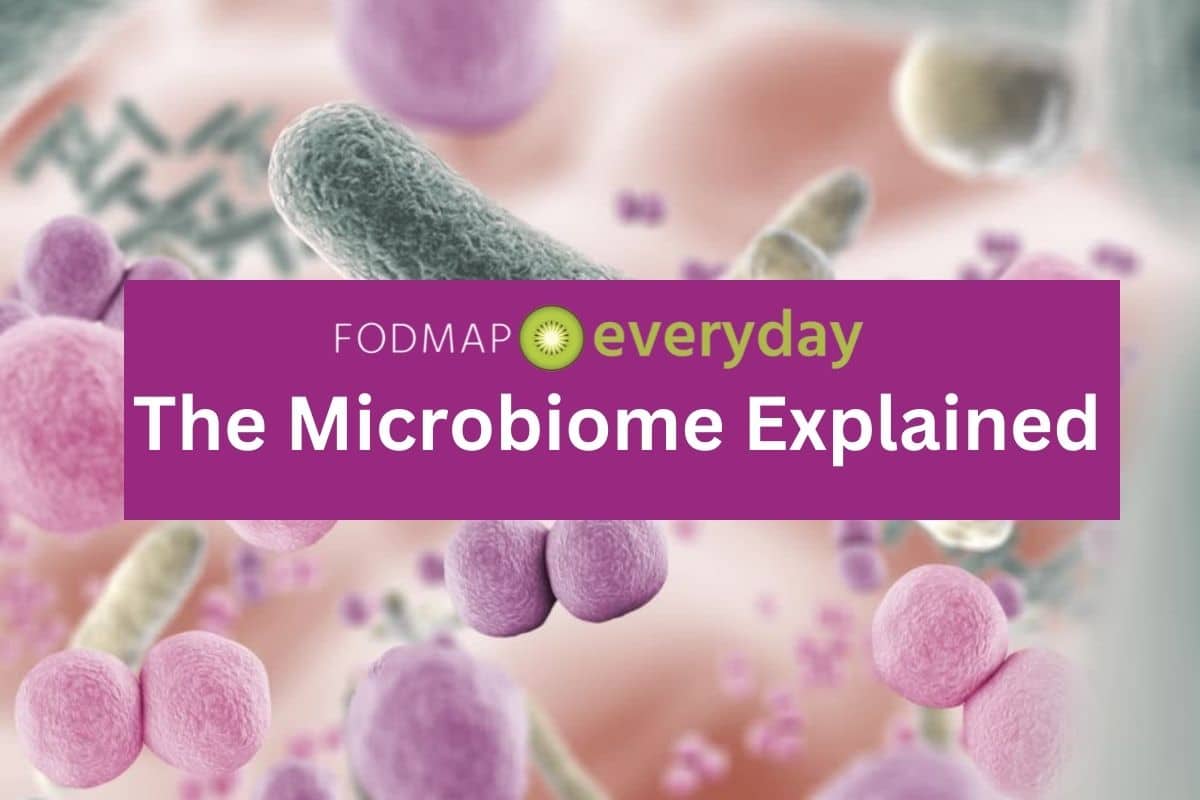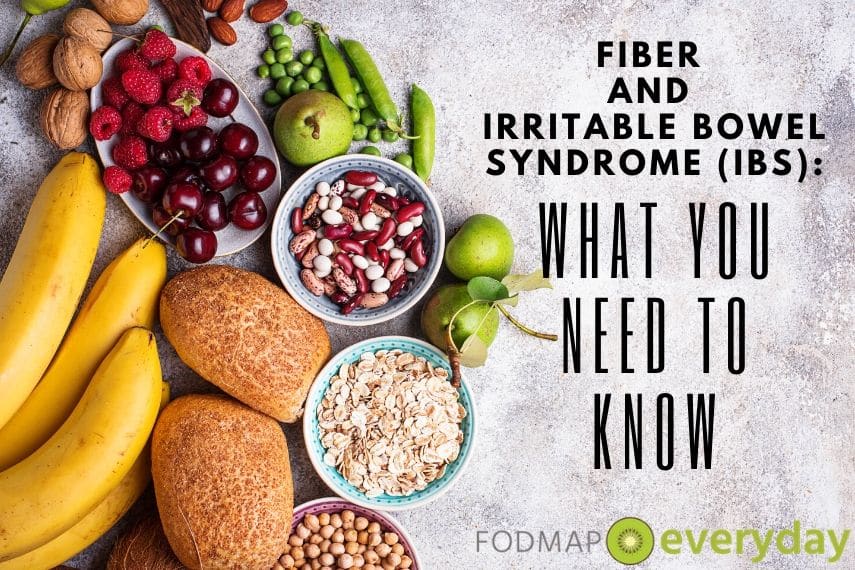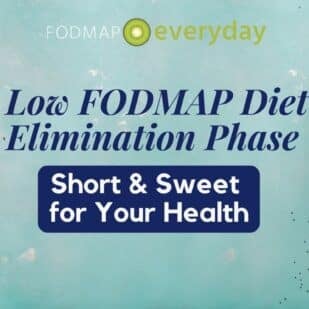Does a Low FODMAP Diet “Disrupt” the Gut-Microbiome? Have you seen it thrown around on social media that the low FODMAP diet may cause “damage” or “disrupt” your gut-microbiome? Perhaps this caused you some worry because you know that the low FODMAP diet has IMMENSELY helped with relieving your irritable bowel syndrome (IBS) symptoms.

So what could be wrong with it? Should you be worried about impacting your gut-microbiome and potentially making your digestive system less healthy and optimal for the long term?
Well, let’s dive into what the research actually shows us – because we know that a lot of what we see on social media can be misleading! You’ve come to the right place today to get the scoop from the “Success Team” here at FODMAP Everyday®.
- What Is The Gut-Microbiome?
- How Does Our Gut-Microbiome Affect Health?
- What Is The Low FODMAP Diet?
- The Connection Between FODMAPs and Our Gut-Microbiome
- Does A Low FODMAP Diet Impact Our Gut-Microbiome?
- What Have We Learned From These Studies?
- How to Nurture Your Microbiome on a Low FODMAP Diet
- The Takeaway
What Is The Gut-Microbiome?
As we approach this topic, let’s get your understanding straight.
The gut microbiome is the term that represents the trillions of microbes, their genetic material and roles, living in your gut (aka your gastrointestinal tract). Your gut is the pathway all the way from your mouth to the other end, your anal canal. The microbiota inhabiting our gut not only include bacteria, but also fungi, protozoa, viruses, and archaea [1].
The gut microbiome is the term that represents the trillions of microbes, their genetic material and roles, living in your gut (aka your gastrointestinal tract).
Fun fact, the gut-microbiome is estimated to include the same amount of bacterial cells as human cells – wild!
Although, there is no universal definition of a healthy gut-microbiome, it is generally agreed upon that a healthy microbiome is rich in beneficial bacteria (such as Bifidobacterium and Lactobacillus) and low in pathogenic bacteria (such as Klebsiella and Escherichia coli) [2,3].
Essentially, a healthy microbiome is a ‘diverse’ microbiome, where beneficial microbes outweigh pathogenic or “opportunistic” microbes. Keep this in mind as we will revisit it later.

You May Want to Read: The Microbiome Explained
How Does Our Gut-Microbiome Affect Health?
The gut-microbiome plays a part in a wide range of essential roles for both our whole body health, such as:
- Mental Health & Mood: helping to produce neurotransmitters such as serotonin which aid in gut-brain signaling.
- Metabolism: allowing for carb/protein/fat utilization, support insulin sensitivity and regulating blood sugar, aiding satiety signaling, and maintaining a healthy weight.
- Digestion: supporting a strong gut lining, breaking down food, fermenting non-digestible fibers to form SCFA (short-chain fatty acids).
- Immunity: acting as a defense mechanism to invading cells and pathogens, fighting infection, helping preventing disease.
Alternatively, changes in the composition of human gut microbiota composition have been associated with disturbed gut barrier functions (such as immunity), increased intestinal permeability, and increased lipopolysaccharide levels in plasma (also known as LPS which are the outer membrane of most gram negative bacteria which can initiate inflammatory pathways in adipose/fat tissue) [4,5].
As a result, these factors can lead to low-grade inflammation which have been thought to trigger the development of obesity and metabolic syndrome [4]. It’s no debate – a diverse and rich microbiome is essential for our whole body health.
What Is The Low FODMAP Diet?
A low FODMAP diet is a 3-step diet used to help manage the symptoms of medically diagnosed irritable bowel syndrome (IBS). FODMAPs are a group of short-chain carbohydrates (aka sugars) that are not fully broken down and absorbed in the digestive tract, which can trigger symptoms in those with IBS (such as bloating, gas, diarrhea, and pain) [6].
The aim of the diet is to help you learn which FODMAPs you tolerate, and which trigger your IBS symptoms. The aim is to improve diet diversity for the long term, while only restricting foods that trigger your IBS symptoms [6].
Learn all about the low FODMAP diet here.
The Connection Between FODMAPs and Our Gut-Microbiome
FODMAPs are fermentable sugars that have prebiotic effects, meaning they do provide a fuel source for beneficial bacteria in our gut.
Thus, the thought is that restricting their intake would have the opposite effect of prebiotic therapy (or supplementing with prebiotic foods) and cause a decrease in bacteria beneficial for gastrointestinal health [7].
Specifically, a beneficial bacteria group known as Bifidobacteria plays an important role in limiting pathogenic colonization and have immunomodulatory properties (aka supports our immune system) [7]. These microbes have been shown to be decreased in a diet that is low in prebiotic fibers.
Does A Low FODMAP Diet Impact Our Gut-Microbiome?
So, does a low FODMAP diet impact the gut-microbiome?
Let’s take a look at two systematic reviews published within the last couple of years.
Note: Systematic reviews, as the name suggests, involve a detailed and comprehensive review on all relevant studies on a particular topic. This is important because we generally don’t want to base a decision on one study alone, looking at a collection of studies is important to give us a more comprehensive picture.
- Effects of Low and High FODMAP Diets on Human Gastrointestinal Microbiota Composition in Adults with Intestinal Diseases: A Systematic Review (2020) [7]
This review looked at a group of studies where the low FODMAP diet was used in patients with a variety of intestinal diseases including irritable bowel syndrome, Crohn’s disease and ulcerative colitis. The general consensus was that restricting non-digestible carbohydrate intake (aka FODMAPs), has an opposite effect of prebiotic supplementation resulting in a reduction in Bifidobacteria and an increase in bacteria associated with dysbiosis or imbalance of microbiota.
However, it was not conclusive whether these effects on the gut-microbiota were long-term as follow-up later on was only present in a small number of the included studies. In addition, most studies reported on the changes seen at the end of the restrictive or ‘Elimination Phase’ after 4-8 weeks but not after reintroduction, where there is naturally an increase in FODMAP diversity again.
- Effects of a low FODMAP diet on the colonic microbiome in irritable bowel syndrome: a systematic review with meta-analysis [8]
Another systematic review looked at the effects of a low FODMAP diet on the colonic (large bowel) microbiome in IBS specifically.The results were interesting – the effects appear to be specific to a decrease in Bifidobacteria with ‘no consistent impacts on other microbiome metrics, including diversity, fecal SCFA concentrations, and fecal pH’.
In short, it appears that the low FODMAP diet can decrease the amount of Bifidobacteria. Decreased numbers of these species in the colon have been associated with several disorders such as IBS, Inflammatory Bowel Disease (IBD), obesity, allergies, antibiotic-associated diarrhea, and regressive (autism) [4].
However, there are obviously lot’s of nuances to these situations, and taking into account what we know about increasing microbiota diversity and Bifidobacteria, this should be a focus for those following a low FODMAP diet.
What Have We Learned From These Studies?
Both studies show that when FODMAPs are restricted for more than 2 months good bacteria diminishes in the gut. So this is why it is important to reintroduce diverse food sources to your diet and to not extend the Elimination Phase for too long. Let’s talk about what you can do to ensure your microbiome remains healthy and happy as you move through the Low FODMAP Diet phases.
You May Want To Read: The Low FODMAP Diet Elimination Phase: Short & Sweet for Your Health!
How to Nurture Your Microbiome on a Low FODMAP Diet
1. Eat Enough Fiber
Fiber acts as a fuel source for our gut-bacteria, which break down fiber to create compounds known as Short Chain Fatty Acids (SCFAs). These SCFAs can help support a strong intestinal wall and mediate inflammation.
Daily fiber requirements are:
- Adult females: 25-30 grams
- Adult males: 35-40 grams
Unfortunately, those following a low FODMAP diet are at risk for low fiber intake.
However, there are lots of low FODMAP fiber rich foods, such as:
- Raspberries (58g)
- Edamame (90g)
- Chia seeds (24g)
- Flax (15g)
- Popcorn (120g)
- Kiwi (150g)
- Kabocha squash (75g)
- Quinoa (155g)
- Potatoes (75g)
Include these regularly, and work with a Registered Dietitian to ensure you’re meeting your needs!

You May Want to Read: Fiber and IBS: What You Need to Know
2. Include Prebiotic Foods
Prebiotic foods act as ‘fuel’ for our good gut bacteria. In particular, Bifidobacteria like inulin.
Oats, bananas, jicama and soy products like tofu are sources of inulin and can be low FODMAP in the appropriate serving sizes..
Plus, include Monash University Green Light servings of foods that are naturally high FODMAP – such as yellow-non-spotted bananas (100g), pickled onions (45g), and even small portions of asparagus (12g) to get inulin!
For the full scoop on prebiotics, we have an article for that: Our Favorite Prebiotic Low FODMAP Foods
3. Consumed Suitable Fermented Foods
Fermented foods contain live microbes as well as many compounds such as bioactive peptides like CLA, exopolysaccharides, and sphingolipids. They have been shown to improve microbiome diversity, lower inflammatory markers, and consequently help improve overall digestive health [9,10].
Low FODMAP fermented foods include:
- Kefir (lactose-free)
- Sauerkraut (20g)
- Kimchi (47g)
- Tempeh (100g)
- Miso paste (12g)
- Sourdough bread, wheat or oat (50g)
- Pickles
Learn all about the low FODMAP diet and food fermentation in our collection of articles: FODMAP and Food Processing Series
4. Don’t Follow The Elimination Phase For Too Long
As we’ve discussed, FODMAPs are types of prebiotics – therefore, it’s important to complete a Challenge/Reintroduction phase of the low FODMAP diet so that you are able to expand your diet and include more diversity. We also know that MORE diversity in the amount of plant foods in our diet, can support a richer diversity in our gut-microbiome.
We strongly suggest reaching out to a Registered Dietitian for support transitioning off the Elimination Phase.
We also have an article that offers great guidance on How To Make The Low FODMAP Diet Elimination Phase Easier To Follow
5. Focus On Stress, Sleep And Lifestyle Support
Did you know that stress can influence your microbiome? Health of our digestion goes FAR past just what we eat – our lifestyle plays a significant role!
Manage stress levels to help support your microbiome. Here’s more on how stress affects your gut and what you can do to help.
You May Want To Read: IBS and Stress: Common Causes and Solutions
The Takeaway
In short, the gut-microbiome is complex, and how it is affected by a dietary pattern can depend on a wide range of individualized factors. While studies have shown a decrease in some beneficial bacteria (particularly Bifidobacteria) and an increase in pathogenic bacteria, the extent of this change and whether it remains after one completes the Challenge/Reintroduction phase of the low FODMAP diet is not certain. In addition, how balanced and diverse the diet was of the subjects in these studies is not entirely clear.
However, it is clear that the low FODMAP diet has brought IBS-sufferers a world of relief. Being able to take your life back by finding IBS symptom control is an IMMEASURABLE benefit.
As we’ve mentioned though, implementing the low FODMAP diet properly by including a diversity of fiber and prebiotic foods, ensuring nutritional adequacy, and not following the Elimination Phase for too long, is of the utmost importance for your success and long-term digestive health.
Implementing the low FODMAP diet properly by including a diversity of fiber and prebiotic foods, ensuring nutritional adequacy, and not following the Elimination Phase for too long, is of the utmost importance for your success and long-term digestive health.
As supported by the most recent guidelines, following a low FODMAP diet through guidance of a FODMAP specialized Registered Dietitian is integral to ensure that nutrient needs are met. Check out our Global Dietitian Directory.
Further, it should be highlighted that when it comes to managing your IBS as well as supporting your gut-microbiome (on a low FODMAP diet, or not) – an integrative approach is essential. Diet, sleep hygiene, stress management, movement, and possibly supplements all factor into your digestive health and wellness!
Here is your handy Checklist:
- A diverse and rich microbiome is essential for our whole body health.
- During the intentionally brief first Elimination Phase, FODMAPs are reduced, which can decrease beneficial bacteria in the gut.
- During the Challenge and Integration Phases of the low FODMAP diet you are reintroducing FODMAPs, which will help reestablish your gut microbiota diversity and quantity of beneficial bacteria, such as Bifidobacteria.
- Present studies suggest that FODMAP restriction can impact the gut-microbiome, however there is a lack of long-term studies and follow-up on these effects and more research is needed.
- A holistic approach to supporting a healthy gut-microbiome is important: diet/nutrition, sleep hygiene, stress management, movement, and possibly tailored supplements all play a role. Work with a specialized Registered Dietitian to develop a personalized and evidence-based IBS management plan that will be sustainable and realistic for you.
REFERENCES:
- Thursby, E., & Juge, N. (2017). Introduction to the human gut microbiota. Biochemical Journal, 474(11), 1823–1836. https://doi.org/10.1042/BCJ20160510
- Shreiner, A. B., Kao, J. Y., & Young, V. B. (2015). The gut microbiome in health and in disease. Current Opinion in Gastroenterology, 31(1), 69–75. https://doi.org/10.1097/MOG.0000000000000139
- Linares, D. M., Ross, P., & Stanton, C. (2015). Beneficial Microbes: The pharmacy in the gut. Bioengineered, 7(1), 11–20. https://doi.org/10.1080/21655979.2015.1126015
- Rivière, A., Selak, M., Lantin, D., Leroy, F., & De Vuyst, L. (2016). Bifidobacteria and Butyrate-Producing Colon Bacteria: Importance and Strategies for Their Stimulation in the Human Gut. Frontiers in Microbiology, 7. https://doi.org/10.3389/fmicb.2016.00979
- Bennett, J. E. (2020). Lipopolysaccharide—Enterobacteriaceae. https://www-sciencedirect-com.subzero.lib.uoguelph.ca/topics/neuroscience/lipopolysaccharide
- Monash University. (n.d.). About FODMAPs and IBS. Retrieved January 22, 2023, from https://www.monashfodmap.com/about-fodmap-and-ibs/
- Vandeputte, D., & Joossens, M. (2020). Effects of Low and High FODMAP Diets on Human Gastrointestinal Microbiota Composition in Adults with Intestinal Diseases: A Systematic Review. Microorganisms, 8(11), 1638. https://doi.org/10.3390/microorganisms8111638
- So, D., Loughman, A., & Staudacher, H. M. (2022). Effects of a low FODMAP diet on the colonic microbiome in irritable bowel syndrome: A systematic review with meta-analysis. The American Journal of Clinical Nutrition, 116(4), 943–952. https://doi.org/10.1093/ajcn/nqac176
- Şanlier, N., Gökcen, B. B., & Sezgin, A. C. (2019). Health benefits of fermented foods. Critical Reviews in Food Science and Nutrition, 59(3), 506–527. https://doi.org/10.1080/10408398.2017.1383355
- Taylor, B. C., Lejzerowicz, F., Poirel, M., Shaffer, J. P., Jiang, L., Aksenov, A., Litwin, N., Humphrey, G., Martino, C., Miller-Montgomery, S., Dorrestein, P. C., Veiga, P., Song, S. J., McDonald, D., Derrien, M., & Knight, R. (2020). Consumption of Fermented Foods Is Associated with Systematic Differences in the Gut Microbiome and Metabolome. 5(2). https://doi.org/10.1128/mSystems.00901-19







